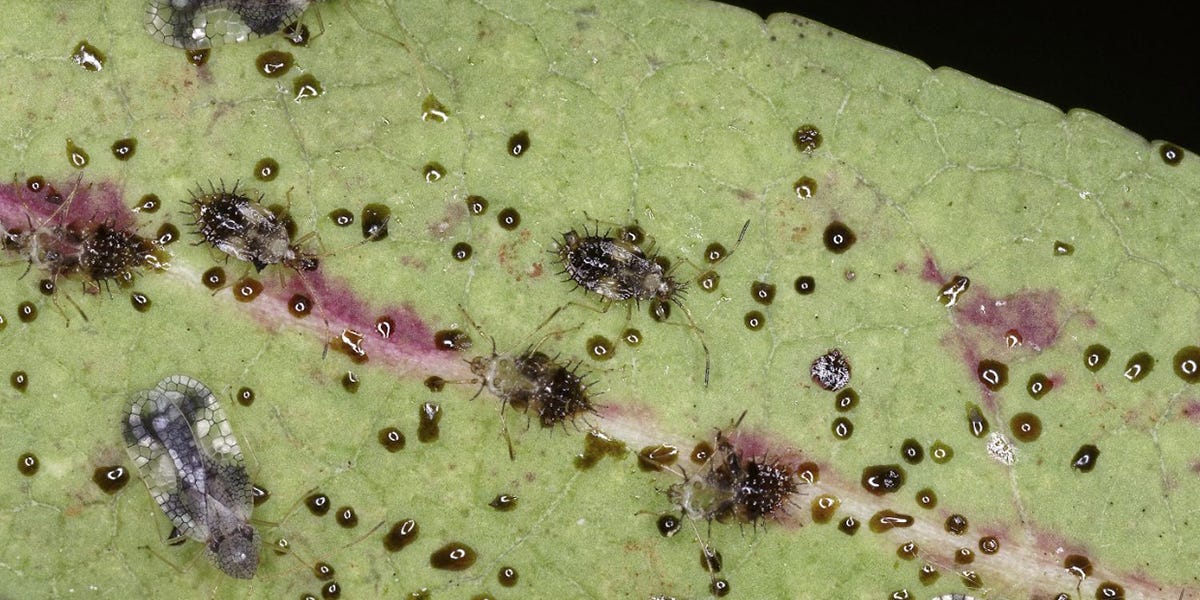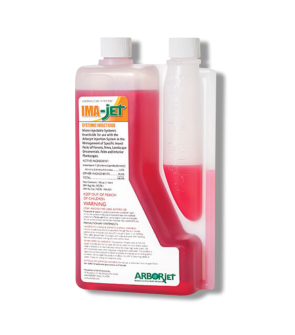Lace Bug Control
Most Effective Products
Lace Bug Control: How to Get Rid of Lace Bugs
This page is a general control guide for lace bugs. Using the products and methods suggested you will get control of lace bugs infestations. Follow this guide and use the recommend products and tips for effective elimination of lace bugs in trees, shrubs, and other landscaped areas in your yard.
Lace bug is a damaging and rampant pest throughout the United States that belong to the insect family Tingidae. Most lace bugs species will infest a specific plant host without moving to other types of shrubbery in your yard. This can be seen with the elm lace bugs, which will infest American elm plant species or the oak lace bugs that only infests oak plants.
This pest is commonly found on azaleas, rhododendrons, sycamore, broad-leaved evergreens, and many other types of trees and shrubs in your homes yard. Though these pests are small in size they can produce a large amount of damage within a short time frame due to their ability to increase in population. Another factor that makes lace bugs an intimidating pest is their ability to reach sexual maturity in as little as 30 days.
Both adult and larvae stages of lace bugs can go undetected until severe damage in desired foliage is presented. Refer to the steps and products listed throughout this DIY guide to prevent and eliminate numerous lace bug species emerging within your ornamental tree, shrubs, and foliage.
Identification

Before proceeding with treatment, you will need to be certain that the type of pest infestation you have is lace bugs. Careless identification can lead you to using the wrong or ineffective insecticides, which can be a waste of your time and finances. While there are several species of lace bugs across the United States they will share some distinguishing traits.
- Lace bugs are small insects that measure up to 1/8 to 1/4 inches long in length.
- Depending on the species, lace bugs are usually white. They can range from dark brown and dark black with white pigmentation.
- Adult lace bugs have transparent wings that extend past their abdomen when not in use. Across its wings will be a netlike pattern that is dotted with brown and black spots.
- In the nymph stage, they are wingless, and have flat oval shaped bodies. If freshly hatched, the nymphs appear translucent then change to a light yellow or green coloration. As lace bugs mature they will become darker, particularly on the abdomen.
- As nymphs, lace bugs will have several pointed spines across its body that stick out in all directions.
Use the image and description above to help you properly identify lace bugs. If you are unsure of the pest inhabiting your ornamental foliage, contact us with a photo or a sample of the pest in a ziplock bag.
Inspection

Once you have confirmed lace bugs on your property, you can proceed with the next phase of treatment which is inspection. During this phase, you will locate the areas where lace bugs are infesting and observe the conditions allowing them to thrive. This information will help you determine where to apply insecticide applications.
Where to Inspect
Adult lace bugs will overwinter in the crevices of bark, branch notches, and other hidden surfaces of their host plants during the winter. They will emerge from their hiding places at the time plant leaves develop in the spring. Throughout the spring season, lace bugs mate and feed on the undersides of leaves near the mid-vein.
Depending on the species, lace bugs are plant specific host that will infest the underside of leaves of various ornamental foliage in your lawn, garden, indoor houseplants, shrubs, trees, and other broad-leaved plants.
What to Look For
Lace bugs have five stages of development known as the egg, first-stage nymph, second-stage nymph, third-stage nymph, then adult. These stages of growth occur within the first 30 days after hatching. Eggs of lace bugs are generally laid along the center of the underside of leaves and covered with dark brown excrement that hardens into a semi-hard protective covering. Their eggs will appear numerous and have a football shape to transparent or cream colored coloration.
At each stage of growth the lace bugs will shed their exoskeleton and these skins will remain attached to the lower part of the infested plant leaves. When reached full maturity the lace bugs will insert their narrow stylets (pierce sucking mouthpart) into the plant tissue to feed. Feeding injury from lace bugs are not as obvious as other insect species as holes are never left. Usually in mid-May to early June you will begin to see small silver, white, or yellow spots creating a bleached appearance across the leaf's surface.
Treatment
When handling or applying any type of pesticide products, you will need to wear the appropriate personal protective equipment (PPE) that protect your hands, mouth, eyes, face, feet, and skin.
The key to removing lace bugs is to apply a liquid residual insecticide containing acephate, bifenthrin, malanthion, or cyfluthrin at the beginning of the year and summer. We recommend using Supreme IT as this product is a liquid insecticide made with the active ingredient bifenthrin 7.9%, which last up to 90 days after application.
Step 1: Water Pressure Application

Both adult and nymph stage of lace bugs are found on the underside of plant leaves. For this reason, you will want to apply a low to medium water pressure to your foliage to wash off any eggs or disturb breeding activity.
Shrubbery that is low to the ground and small in height should be applied with a low water pressure. Foliage that is thick in density and tall in height may be applied with a medium water pressure. Test a small portion of your plant with either water pressure to avoid damage plant leaves and stems.
Spray no more than once a week with an inch or irrigation to avoid overwatering ornamental foliage and landscape.
Step 2: Apply Supreme IT

Determine how much Supreme IT to use by calculating the square footage of your treatment area. To find this, measure the length and width of the treatment area in feet and multiply (length X width = square footage). To treat for lace bugs, use 0.125 to 0.25 oz. of Supreme IT per gallon of water per 1,000 sq. ft.
We recommend using a hose-end sprayer to reach tall foliage heights and large-scale areas. To prepare this spray solution, pour the measured amount of Supreme IT into the hose-end sprayer then attach to the end of the garden hose. Once attached, spray until the appropriate amount of water is mixed with the solution. Once evenly mixed treat the top and bottom of foliage leaves until wet, but not to the point of run-off.
To avoid plant damage, refer to the product label and species of plant being infested before insecticide application. Supreme IT may be applied to lawns, trunk of woody ornamentals, trees, shrubs, ground cover, bedding plants, foliage plants, flowers, non-bearing fruit and nut trees.
Prevention

After you have successfully eliminated lace bugs from your yard, you will want to ensure that these pests do not return. Here are some preventative measures we suggest for keeping lace bugs away from your ornamental foliage, trees, and shrubbery.
- Keep your plants well-watered with an inch of irrigation no more than once a week. This will help to not only strengthen your plants, but also remove any potential lace bug eggs and breeding activity.
- Properly prune foliage of dead or decaying leaves and stems.
- Rake your lawn and areas surrounding ornamental foliage of dead leaves and branches to remove food sources and habitat.
- Replace soil at the beginning of the fall season and cover plants with appropriate covering to prevent overwintering.
- Continue to spray insecticides like Supreme IT every 90 days or at the beginning of each season. Lace bugs and their larvae tend to feed on the bottom of plant leaves, but may move to top of plant surfaces if not treated with any pesticides. For this reason, spray the top and bottom of plant leaves.
Key Takeaways
What are Lace Bugs?
- Lace bugs are common pests found on various ornamental and broad-leaved foliage in yards. Unlike other insect pests, lace bugs feed on the juices (chlorophyll) of plant tissue leaving discoloration and wilting on plant leaves.
How to Get Rid of Lace Bugs
- Lace bugs and nymphs tend to thrive in large clusters along the underside of plant leaves. For this reason, we recommend using a low to medium spray water pressure to remove any eggs and actively growing lace bugs. Once this has been performed, you may spray with a liquid insecticide that is approved to treat your plant species. We recommend using Supreme IT as this product is formulated as a liquid and can treat lawns, tree, shrubs, and other type of foliage.
Preventing Lace Bugs Reinfestation
- Carefully examine the underside of plant leaves or the ground beneath them for shed skin and other signs of lace bug activities. Spray Supreme IT at the beginning of each season to control and cease lace bug activities. Maintain your foliage by pruning, raking, and replacing the soil to remove food and habitat sources.













































































































































































































































































































































































































































































































































